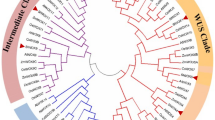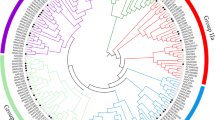Abstract
Whirly (Why) transcription factor (TFs) constitute one of the important TF families which plays essential roles in plant metabolism to cope with environmental stresses. In the present study, Why genes were identified at genome-wide scale in tomato (Solanum lycopersicum), and bioinformatics analyses were implemented. Validation of Why genes expressions under drought and salt stresses were also performed using RT-qPCR. The analyses revealed the presence of two Why genes in tomato genome, SlWhy1 (Solyc05g007100.2.1) and SlWhy2 (Solyc11g044750.1.1). Both genes contained Whirly transcription factor domain structure (PF08536), and Why proteins were in basic character (pI ≥ 7). While the lengths of the proteins ranged from 268 to 236 amino acid residues for SlWhy1 and SlWhy2 respectively, exon numbers identified in both genes were seven. According to the digital expression data, SlWhy genes are expressed at medium level in different anatomical parts and developmental stages. In the promotor sequence analysis, 13 types of putative TF binding sites were identified, and the highest motif number was 46, found for GATA TF. Gene co-expression analyses revealed that complex networks for SlWhy genes, which are connected with various metabolic pathways. Based on the RT-qPCR data, both SlWhy1 and SlWhy2 genes were up-regulated under salt and drought stresses. 3D structure analyses revealed that SlWhy1 protein had a more diverged structure than SlWhy2 protein, based on their comparisons in Arabidopsis and potato. The results obtained in the present study could be a useful scientific basis for understanding Why genes in tomato and their functions under abiotic stress conditions.








Similar content being viewed by others
References
Zhao SY, Wang GD, Zhao WY, Zhang S, Kong FY, Dong XC, Meng QW (2018) Overexpression of tomato WHIRLY protein enhances tolerance to drought stress and resistance to Pseudomonas solanacearum in transgenic tobacco. Biol Plant 62:55–68
Franco-Zorrilla JM, López-Vidriero I, Carrasco JL, Godoy M, Vera P, Solano R (2014) DNA-binding specificities of plant transcription factors and their potential to define target genes. PNAS 111:2367–2372
Desveaux D, Subramaniam R, Després C, Mess JN, Lévesque C, Fobert PR, Dangl JL, Brisson N (2004) A “Whirly” transcription factor is required for salicylic acid-dependent disease resistance in Arabidopsis. Dev Cell 6(2):229–240
Prikryl J, Watkins KP, Friso G, van Wijk KJ, Barkan A (2008) A member of the Whirly family is a multifunctional RNA-and DNA-binding protein that is essential for chloroplast biogenesis. Nucleic Acids Res 36(16):5152
Foyer CH, Karpinska B, Krupinska K (2014) The functions of Whirly1 and redox-responsive transcription factor 1 in cross tolerance responses in plants: a hypothesis. Philos Trans Royal Soc B 369(1640):20130226
Isemer R, Mulisch M, Schäfer A, Kirchner S, Koop HU, Krupinska K (2012) Recombinant Whirly1 translocates from transplastomic chloroplasts to the nucleus. FEBS Lett 586:85–88
Maréchal A, Parent JS, Sabar M, Veronneau-Lafortune F, Abou-Rached C, Brisson N (2008) Overexpression of mtDNA associated AtWhy2 compromises mitochondrial function. BMC Plant Biol 8:42
Cai Q, Guo L, Shen ZR, Wang DY, Zhang Q, Sodmergen S (2015) Elevation of pollen mitochondrial DNA copy number by WHIRLY2: altered respiration and pollen tube growth in Arabidopsis. Plant Physiol 169:660–673
Desveaux D, Després C, Joyeux A, Subramaniam R, Brisson N (2000) PBF-2 is a novel single-stranded DNA binding factor implicated in PR-10a gene activation in potato. Plant Cell 12:1477–1490
Desveaux D, Allard J, Brisson N, Sygusch J (2002) A new family of plant transcription factors displays a novel ssDNA-binding surface. Nat Struct Biol 9:512–517
Janack B, Sosoi P, Krupinska K, Humbeck K (2016) Knockdown of WHIRLY1 affects drought stress-induced leaf senescence and histone modifications of the senescence-associated gene HvS40. Plants 5:37
Krupinska K, Oetke S, Desel C, Mulisch M, Schäfer A, Hollmann J, Kumlehn J, Hensel G (2014) WHIRLY1 is a major organizer of chloroplast nucleoids. Front Plant Sci 5:432
Goodstein DM, Shu S, Howson R, Neupane R, Hayes RD, Fazo J, Mitros T, Dirks W, Hellsten U, Putnam N, Rokhsar DS (2012) Phytozome: a comparative platform for green plant genomics. Nucleic Acids Res 40:1178–1186
Punta M, Coggill PC, Eberhardt RY, Mistry J, Tate J, Boursnell C (2012) The Pfam protein families database. Nucleic Acids Res. 40(Database Issue):D290–D301
Gasteiger E, Hoogland C, Gattiker A, Wilkins MR, Appel RD, Bairoch A (2005) Protein identification and analysis tools on the ExPASy server. Springer, The proteomics protocols handbook, pp 571–607
Horton P, Park KJ, Obayashi T, Fujita N, Harada H, Adams-Collier CJ, Nakai K (2007) WoLF PSORT: protein localization predictor. Nucleic Acids Res 35:W585–W587
Hall TA (1999) BioEdit: a user-friendly biological sequence alignment editor and analysis program for Windows 95/98/NT. Nucleic Acids Symp Ser 41:95–98
Timothy L, Mikael Bode´n B, Buske FA, Frith M, Grant CE, Clementi L, Ren J, Li WW, Noble WS (2009) MEME SUITE: tools for motif discovery and searching. Nucleic Acids Res 37:202–208
Kumar S, Stecher G, Tamura K (2016) MEGA7: molecular evolutionary genetics analysis version 7.0 for bigger datasets. Mol Biol Evol 33:1870–1874
Zuckerkandl E, Pauling L (1965) Evolutionary divergence and convergence in proteins. In: Bryson V, Vogel HJ (eds) Edited in evolving genes and proteins. Academic Press, New York, pp 97–166
Chow CN, Zheng HQ, Wu NY, Chien CH, Huang HD, Lee TY, Chiang-Hsieh YF, Hou PF, Yang TY, Chang WC (2016) PlantPAN 2.0: an update of plant promoter analysis navigator for reconstructing transcriptional regulatory networks in plants. Nucleic Acids Res 44:D1154–D1160
Hruz T, Laule O, Szabo G, Wessendorp F, Bleuler S, Oertle L, Widmayer P, Gruissem W, Zimmermann P (2008) Genevestigator v3:a reference expression database for the meta-analysis of transcriptomes. Adv Bioinform 2008:420747
Dai X, Zhao PX (2011) psRNATarget: a plant small RNA target analysis server. Nucleic Acids Res 39:W155–W159
Geourjon C, Deleage G (1995) SOPMA: signifcant improvements in protein secondary structure prediction by consensus prediction from multiple alignments. Comput Appl Biosci 11:681–684
Kelley LA, Sternberg MJ (2009) Protein structure prediction on the Web: a case study using the Phyre server. Nat Protoc 4:363–371
Willard L, Ranjan A, Zhang H, Monzavi H, Boyko RF, Sykes BD, Wishart DS (2003) VADAR: a web server for quantitative evaluation of protein structure quality. Nucleic Acids Res 31:3316–3319
Zhang Y, Skolnick J (2005) TM-align: a protein structure alignment algorithm based on TM-score. Nucleic Acids Res 33:2302–2309
Holm L, Laakso LM (2016) Dali server update. Nucleic Acids Res 44(W1):W351–W355
Swami AK, Alam SI, Sengupta N, Sarin R (2011) Differential proteomic analysis of salt stress response in Sorghum bicolor leaves. Environ Exp Bot 71:321–328
Goupil P, Souguir D, Ferjani E, Faure O, Hitmi A, Ledoigt G (2009) Expression of stress-related genes in tomato plants exposed to arsenic and chromium in nutrient solution. J Plant Physiol 166:1446–1452
Livak KJ, Schmittgen TD (2001) Analysis of relative gene expression data using real-time quantitative PCR and the 2 − ΔΔCT method. Methods 25:402–408
Desveaux D, Maréchal A, Brisson N (2005) Whirly transcription factors: defense gene regulation and beyond. Trends Plant Sci 10:95–102
Khodakovskaya M, Dervishi E, Mahmood M, Xu Y, Li Z, Watanabe F, Biris AS (2009) Carbon nanotubes are able to penetrate plant seed coat and dramatically affect seed germination and plant growth. ACS Nano 3:3221–3227
Khodakovskaya M, Sword C, Wu Q, Perera IY, Boss WF, Brown CS, Winter Sederoff H (2010) Increasing inositol (1,4,5)-trisphosphate metabolism affects drought tolerance, carbohydrate metabolism and phosphate-sensitive biomass increases in tomato. Plant Biotechnol J 8:170–183
Ozaki S, Ogata Y, Suda K, Kurabayashi A, Suzuki T, Yamamoto N, Iijima Y, Tsugane T, Fujii T, Konishi C, Inai S, Bunsupa S, Yamazaki M, Shibata D, Aoki K (2010) Coexpression analysis of tomato genes and experimental verification of coordinated expression of genes found in a functionally enriched coexpression module. DNA Res 17:105–116
Fukushima A, Nishizawa T, Hayakumo M, Hikosaka S, Saito K, Goto E, Kusano M (2012) Exploring tomato gene functions based on coexpression modules using graph clustering and differential coexpression approaches. Plant Physiol 158:1487–1502
Cantu D, Blanco-Ulate B, Yang L, Labavitch JM, Bennett AB, Powell AL (2009) Ripening-regulated susceptibility of tomato fruit to Botrytis cinerea requires NOR but not RIN or ethylene. Plant Physiol 150:1434–1449
Reyes JC, Muro-Pastor MI, Florencio FJ (2004) The GATA family of transcription factors in Arabidopsis and rice. Plant Physiol 134:1718–1732
Ambawat S, Sharma P, Yadav NR, Yadav RC (2013) MYB transcription factor genes as regulators for plant responses: an overview. Physiol Mol Biol Plants 19:307–321
Aravind L, Landsman D (1998) AT-hook motifs identified in a wide variety of DNA-binding proteins. Nucleic Acids Res 26:4413–4421
Lee HK, Hsu AK, Sajdak J, Qin J, Pavlidis P (2004) Co-expression analysis of human genes across many microarray data sets. Genome Res 14:1085–1094
Usadel B, Obayashi T, Mutwil M, Giorgi FM, Bassel GW, Tanimoto M, Chow A, Steinhauser D, Persson S, Provart NJ (2009) Co-expression tools for plant biology: opportunities for hypothesis generation and caveats. Plant, Cell Environ 32:1633–1651
Riggs JW, Cavales PC, Chapiro SM, Callis J (2017) Identification and biochemical characterization of the fructokinase gene family in Arabidopsis thaliana. BMC Plant Biol 17:83
Xu XM, Meulia T, Meier I (2007) Anchorage of plant RanGAP to the nuclear envelope involves novel nuclear-pore-associated proteins. Curr Biol 17:1157–1163
Duque P (2011) A role for SR proteins in plant stress responses. Plant Signal Behav 6:49–54
Rao RS, Salvato F, Thal B, Eubel H, Thelen JJ, Moller IM (2017) The proteome of higher plant mitochondria. Mitochondrion 33:22–37
Drążkowska K, Tomecki R, Stoduś K, Kowalska K, Czarnocki-Cieciura M, Dziembowski A (2013) The RNA exosome complex central channel controls both exonuclease and endonuclease Dis3 activities in vivo and in vitro. Nucleic Acids Res 41:3845–3858
Pearce FG, Hudson AO, Loomes K, Dobson RC (2017) Dihydrodipicolinate synthase: structure, dynamics, function, and evolution. In: Robin Harris J, Marles-Wright J (eds) Macromolecular protein complexes. Cham, Springer, pp 271–289
Schapire AL, Valpuesta V, Botella MA (2006) TPR proteins in plant hormone signaling. Plant Signal Behav 1:229–230
Gerke V, Creutz CE, Moss SE (2005) Annexins: linking Ca 2 + signalling to membrane dynamics. Nat Rev Mol Cell Biol 6(6):449
Carrington JC, Ambros V (2003) Role of microRNAs in plant and animal development. Science 301:336–338
Sunkar R, Li YF, Jagadeeswaran G (2012) Functions of microRNAs in plant stress responses. Trends Plant Sci 17:196–203
Xie F, Jones DC, Wang Q, Sun R, Zhang B (2015) Small RNA sequencing identifies miRNA roles in ovule and fiber development. Plant Biotechnol J 13:355–369
Author information
Authors and Affiliations
Contributions
EF and MAA—conceived the study, conducted the experiments, wrote the manuscript.
Corresponding authors
Ethics declarations
Conflict of interest
The authors declare no conflict of interest.
Ethical approval
This article does not contain any studies with human participants or animals performed by any of the authors.
Additional information
Publisher's Note
Springer Nature remains neutral with regard to jurisdictional claims in published maps and institutional affiliations.
Rights and permissions
About this article
Cite this article
Akbudak, M.A., Filiz, E. Whirly (Why) transcription factors in tomato (Solanum lycopersicum L.): genome-wide identification and transcriptional profiling under drought and salt stresses. Mol Biol Rep 46, 4139–4150 (2019). https://doi.org/10.1007/s11033-019-04863-y
Received:
Accepted:
Published:
Issue Date:
DOI: https://doi.org/10.1007/s11033-019-04863-y




